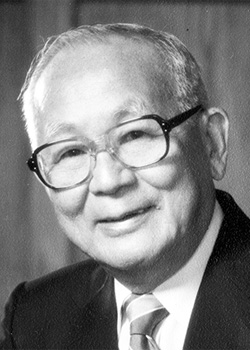Hara attended Royal School before entering the Punahou Academy for high school. After graduating from Punahou, Hara studied engineering at the University of Hawai‘i for three years before attending architecture school at the University of Southern California where he graduated in 1935. Hara returned to Hawai‘i shortly after.
Ernest Hara’s place in Hawai‘i’s architectural history is secured not only by the architecture he produced, but for being at the forefront of change in the social context of who architecture was done for. After World War II, Ernest Hara was one of the first Asian Americans to open his own architectural firm and he became one of the most successful Hawai‘i architects in the three decades after the war. His influence extended to positions in the community, either being a founder or founding member of several organizations.
Throughout his career, Hara reminded the entire profession about the importance of the Pacific Basin and worked to develop connections between architects in the West, particularly Hawai‘i, and the East, particularly Japan.
Ernest Hara was born in 1909 to Issei parents married earlier that same year. His father, Naoyuki Hara ran a plumbing and sheet metal shop in Honolulu.
Hara attended Royal School before entering the Punahou Academy for high school. After graduating from Punahou Hara studied engineering at the University of Hawai‘i for three years before attending architecture school at the University of Southern California, graduating in 1935. Within 45 days of his return to Hawai‘i, he landed his first job with Claude Stiehl.
When he joined the firm, Stiehl was designing the Church of the Crossroads. The influence of Stiehl’s design and use of cast stone elements can be seen in some of Hara’s later design work. Hara also credits Stiehl with exposing him to the use of Asian design motifs in residential construction.
When Stiehl left Hawai‘i in 1940, Hara went to work for Guy Rothwell and then in June of 1941, was offered a job with C.W. Dickey and Associates. At the time, Dickey’s office paid Asian architects $55 a week, but paid mainland architects $75 a week. Hara, who was the only one in Hawai‘i to pass the architecture exam that year, refused to accept the job without pay equity. He was hired, on his terms. It was his “first experience of being discriminated [against] on the salary scale.” He resolved he would never let that happen in his own office.
When World War II started, Hara’s architectural career, like most others’, was put on hold but as the war wound down toward the end 1945, he also started doing some architectural work on the side, using a drafting board in the back of his father’s plumbing shop.
Hara’s practice quickly became much diversified, with single-family residential, schools, apartments, hotels and business buildings being the bulk of his work. By 1982, there were at least 43 major school projects (8 of them in Guam) listed in Hara’s resume, about 36 significant apartment hotel projects and 32 commercial projects.
In 1950, Hara’s first major school project, Robert Louis Stevenson School, was completed. In the early 1950’s Hara designed the first of his buildings for Punahou School, the McNeil Science Building. It was first of many for the Punahou alum: a renovation of Castle Hall, the Punahou School Library, Bishop Hall, the Administration Building, and in a joint venture with his son John Hara, FAIA, the Punahou School Athletic Facilities in 1979.
Hara’s long volunteer and professional service at Punahou School led to his 17-year tenure as a trustee of the school beginning in 1969, once again breaking new ground. He left only when he reached the mandatory retirement age of 75, and still continued his support of the school as a Trustee Emeritus.
The same year he became a Punahou Trustee, Hara helped start the Foundation for Study in Hawai‘i and Abroad.
In the 1930’s, Hara made the first of what would be many trips to Japan. Some of those trips would be for business. Many others were tours with fellow architects that promoted broader understanding and working relationships between architects in Japan and the US. Hara’s goal of promoting cross-cultural understanding was integral in the formulation, drafting and execution of the JIA-AIA Accord on Professionalism in 1989. His cross-cultural efforts led to Hara being awarded the Order of the Rising Sun, Fourth Class, from Japan in 1984.
In a life filled with honors of the highest order, it would be easy to say that Ernest Hara might have his positive manner because of them. But it was obvious to anyone who met him that his positive attitude was a basic part of his success.
SIGNIFICANT PROJECTS:
1960 Ala Wai Palms
1962 Waikīkī Grand Hotel
1966 Aloha Surf Hotel
1966 Atlas Insurance Building
1967 Hono Hale Towers
1968 Waikīkī Resort Hotel
1968 Queen Kapi‘olani Hotel
1968 Pacific Grand Hotel
1971 Hilo Lagoon Hotel
1973 Scenic Towers
1975 Waikīkī Shopping Plaza
1976 Hilo Hawaiian Hotel
1978 Pi‘ikoi Trade Center
1981 Central Pacific Bank
